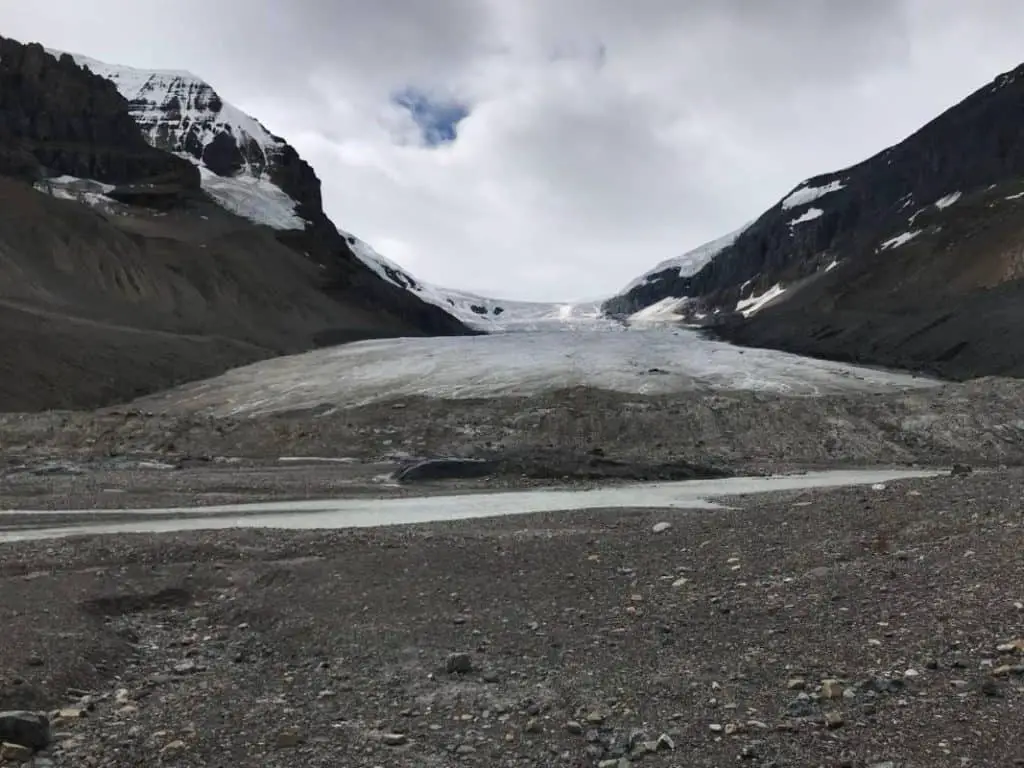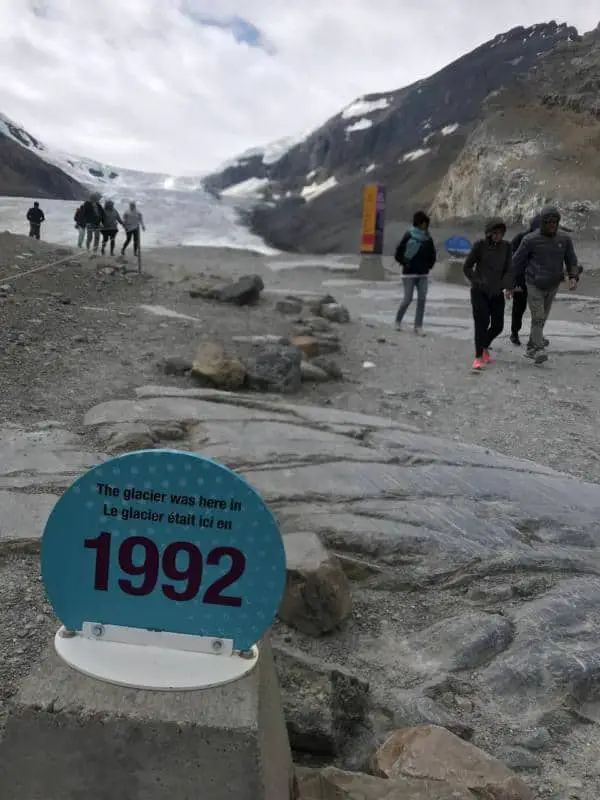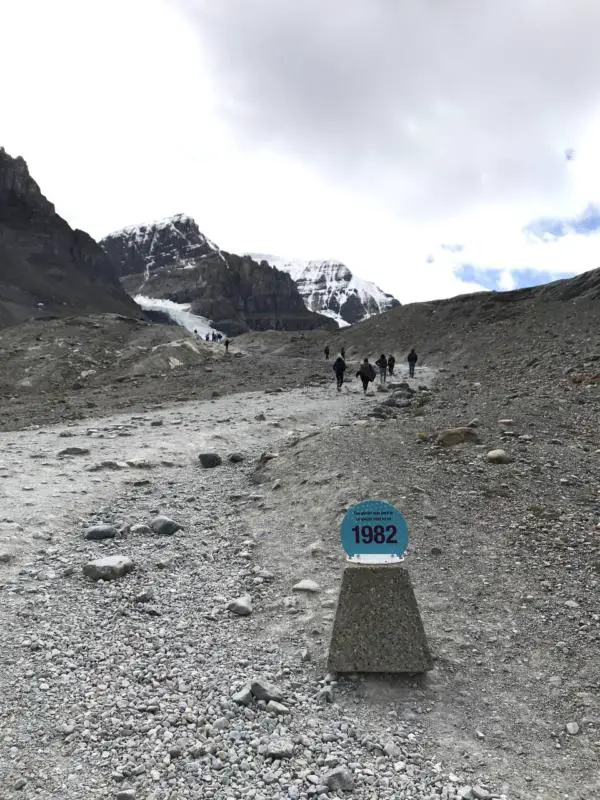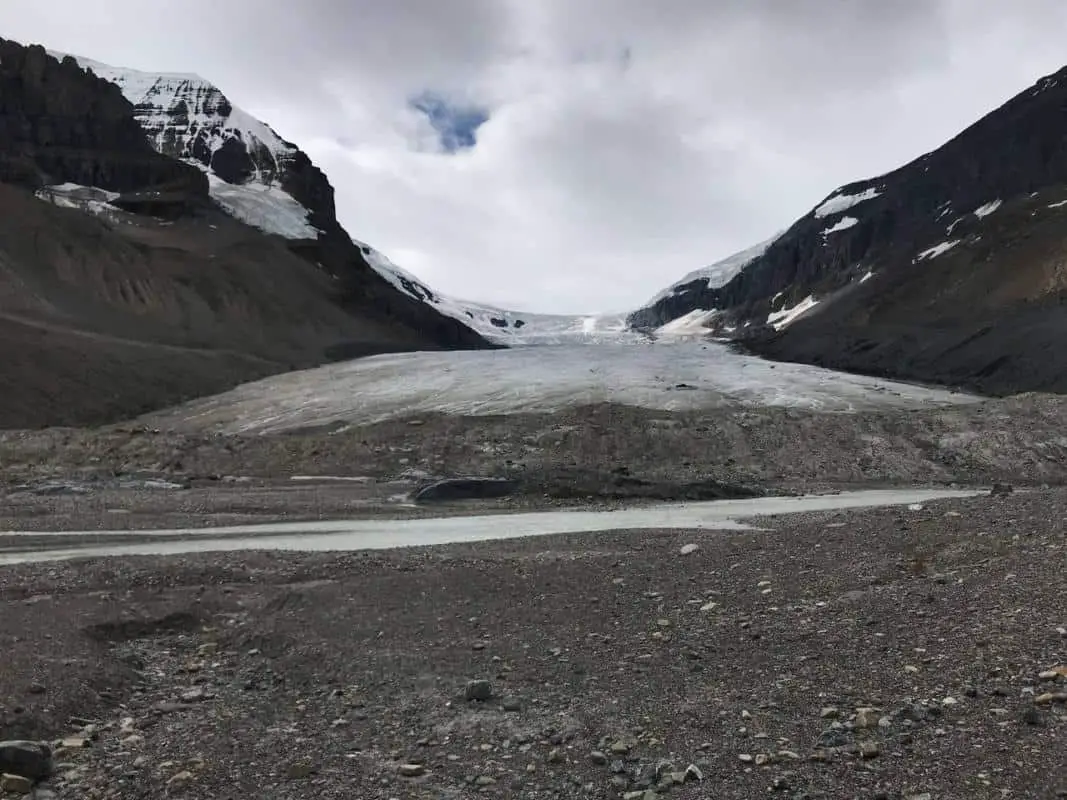Glaciers are one of Banff’s most breathtaking features. There are more than 1,000 (!) in the park, some of which are famous. In this post, you’ll read everything you need to know about these massive bodies of ice.
Glaciers play a vital role in Banff’s ecosystem. They provide fresh water to rivers and streams and serve as critical habitats for various plant and animal species.
The largest mass of glacial ice in the North American Rockies is the Columbia Icefield, which spans an area of 325 square kilometers (125.48 sq mi) and feeds several large glaciers.
While the Columbia Icefield technically is in Jasper National Park, you can easily reach it from Banff by driving the Icefields Parkway (Highway 93).
While the Columbia Icefield is undoubtedly impressive, other Banff National Park glaciers are also worth exploring. Hiking trails like the Plain of Six Glaciers allow you to get close to these natural wonders.
Glaciers in Banff National Park: the Most Famous Ones
Below is a list of the eleven most prominent glaciers in Banff National Park and along the Icefield Parkway in Jasper National Park.
- Athabasca Glacier: Located in the Columbia Icefield area along the Icefields Parkway, this is the largest glacier in the park and one of the most accessible. You can take an Ice Explorer tour or hike to the glacier from the Columbia Icefield Centre.
- Victoria Glacier: Located near Lake Louise, the glacier is visible from several viewpoints around the lake, including the Lake Louise shoreline and the Fairmont Château Lake Louise. The glacier is named after Queen Victoria.
- Bow Glacier: Located in the Wapta Icefield, this glacier is visible from the popular Bow Lake hiking trail. The glacier is also accessible via a guided ice walk from the Num-Ti-Jah Lodge.
- Vulture Glacier: Also located in the Wapta Icefield, Vulture Glacier is an outflow glacier along the Continental Divide. It’s one of the most accessible glaciers in the park. However, getting there still is a strenuous and challenging trek.
- Castleguard Glacier: Located in the Columbia Icefield area, this glacier is one of the largest in Jasper National Park and is accessible via a challenging mountaineering route.
- Crowfoot Glacier: Located along the Icefields Parkway, this glacier is visible from the Bow Summit lookout. The glacier is named for its shape, which resembles a crow’s foot.
- Hector Glacier: Located in the Waputik Range, this glacier is visible from the Icefields Parkway. The glacier is named for James Hector, a geologist who explored the area in the 19th century.
- Peyto Glacier: Located in the Wapta Icefield, this glacier is visible from the Peyto Lake viewpoint. The glacier is named for Bill Peyto, a legendary mountain guide in the early 20th century.
- Saskatchewan Glacier: Located in the Columbia Icefield area, this glacier is the second-largest in Jasper National Park and is accessible via a guided ice walk or a challenging mountaineering route.
Below, I included a map indicating the nine glaciers described above and a distance table indicating the distance to get (close) to the glacier from Banff and Lake Louise.
Glaciers Distance Table
If you plan to visit Banff National Park, knowing the distance to the glaciers from Banff and Lake Louise is important. Here’s a table showing the distance in kilometers and miles:
| GLACIER | Distance from Banff | Distance from Lake Louise |
|---|---|---|
| Athabasca Glacier | 185 km (115 mi) | 130 km (81 mi) |
| Bow Glacier | 95 km (59 mi) | 41 km (25 mi) |
| Castleguard Glacier | 165 km (103 mi) | 116 (72 mi) |
| Crowfoot Glacier | 92 km (57 mi) | 37 km (23 mi) |
| Hector Glacier | 79 km (49 mi) | 24 km (15 mi) |
| Peyto Glacier | 101 km (63 mi) | 46 km (29 mi) |
| Saskatchewan Glacier | 165 km (103 mi) | 116 km (72 mi) |
| Victoria Glacier | 62 km (39 mi) | 4.4 km (2.73 mi) |
| Vulture Glacier | 95 km (59 mi) | 41 km (25 mi) |
How Do Glaciers Form?
Glaciers are formed over centuries as snow accumulates and compresses into ice. The weight of the ice forces it to flow downhill as more snow falls, sculpting canyons and shaping the landscape. The temperature and amount of snowfall in an area are key factors in determining whether a glacier will form.
Types of Glaciers in Banff National Park
Banff National Park is home to different kinds of glaciers. These include valley, cirque, and hanging glaciers.
Valley Glacier
Valley glaciers, including the Columbia Icefield, are the most common and can be found throughout the park. A valley glacier is a type of glacier that forms in a valley or a canyon.
It is a river of ice flowing down the valley, slowly carving the landscape over time. Valley glaciers are typically found in mountainous regions and are formed when snow accumulates and compresses into ice.
As the ice moves down the valley, it can pick up rocks and other debris, which can help to erode the surrounding rock and create new landforms.
Famous valley glacier in Banff: Saskatchewan Glacier
Cirque Glaciers
Cirque glaciers are smaller and are typically found in high mountain valleys.
A cirque glacier forms in a bowl-shaped depression on the side of a mountain. This depression is called a cirque and is typically formed by erosion from ice and water over thousands of years.
As snow accumulates in the cirque, it compresses into ice and flows downhill, forming a glacier.
Cirque glaciers are usually smaller than valley glaciers. They are in high-elevation areas, often nestled beneath the highest peaks. The glacier can carve out new landforms and create beautiful landscapes as it moves.
Famous cirque glacier in Banff: Peyto Glacier
Hanging Glaciers
Hanging glaciers are located on the sides of mountains and are often visible from a distance.
A hanging glacier originates high on the wall of a glacial valley. It descends only part of the way to the surface of the main glacier. It abruptly stops, typically at a cliff, and does not reach the valley floor below.
Hanging glaciers are often found in mountainous regions and can be fed by snow and ice from other glaciers. As the hanging glacier moves, it can cause avalanches and icefalls that transfer ice and snow to the valley floor below.
Some hanging valleys can also have waterfalls that form after deglaciation.
Famous hanging glacier in Banff: Victoria Glacier
The Columbia Icefield

The Columbia Icefield is a large icefield in the Canadian Rockies, straddling the border between Alberta and British Columbia, Canada. It is one of North America’s most significant accumulations of ice and snow, covering an area of approximately 325 square kilometers.
The icefield feeds several glaciers, including the Athabasca Glacier, one of the most accessible glaciers in the world.
The Columbia Icefield is the most popular tourist attraction along the Icefields Parkway between Lake Louise and Jasper.
Here you can embark on the Columbia Icefield Adventure. It takes you on a guided tour of the Athabasca Glacier aboard an Ice Explorer vehicle, a specialized all-terrain vehicle transporting tourists across the Columbia Icefield.
It has been specifically designed to navigate the rugged terrain of the icefield, with large, low-pressure tires that allow it to easily travel over snow and ice.
The Ice Explorer can carry up to 56 passengers at a time.
Columbia Icefield Discovery Centre
The Columbia Icefield Discovery Centre is the visitor center at the Columbia Icefield.
You can buy several activities and tours here, including guided hikes, glacier walks, and a skywalk that allows you to walk on a horseshoe-shaped glass platform above the Sunwapta Valley.
The center also features exhibits and displays that provide information on the area’s geology, ecology, and history, as well as the impact of climate change on the region’s glaciers.
And, not to forget, you can also enjoy dining at the center’s two restaurants, Altitude and Chalet. The center also has a gift shop.
Hike to Glaciers in Banff
If you want to see a glacier up close by hiking there, you have several options in Banff National Park.
But don’t take it lightly (see subheading Risk of Visiting Glaciers)!
You should have the necessary skills and experience to undertake them safely. Always check with park authorities for the latest information on conditions and safety precautions.
Some of the mountaineering tours to glaciers in Banff National Park include:
- Columbia Icefield: The Columbia Icefield offers a range of mountaineering routes for experienced climbers, including routes to the summits of Mount Athabasca and Mount Andromeda.
- Wapta Icefield: The mountaineering routes on the Wapta Icefield include the classic Wapta Traverse. It takes climbers across the icefield and over several peaks.
- Mount Victoria: Mount Victoria is a popular mountaineering destination in Banff National Park, with several routes to the summit. It includes the classic North Ridge.
- Mount Temple: Mount Temple is one of the highest peaks in Banff National Park. It offers several challenging mountaineering routes to the summit.
All these routes require advanced mountaineering skills. You should only attempt it if you’re an experienced climber and possess the appropriate equipment.
More accessible hikes to glaciers are the Plain of the Six Glaciers trail. This is a 14.6-km (9.07 mi) out-and-back trail near Lake Louise with an elevation of 588 meters (1,929 ft). It takes about 4.5 hours to complete.
Alternatively, you can hike to the base of the Athabasca Glacier at the Columbia Icefield. It’s an easy 15-minute walk from the parking lot on the left side of the Icefields Parkway (coming from the direction of Banff).
Risks of Visiting Glaciers
Visiting glaciers can be a thrilling experience, but it can also be dangerous. You should know the risks of visiting them. They include:
- Falling ice: Falling ice occurs in areas where the glacier is broken up by large crevasses and ice towers. These areas can be unstable and can collapse without warning.
- Crevasses: Glaciers are constantly moving and can have hidden crevasses that are difficult to see. Falling into a crevasse can be dangerous or even fatal.
- Avalanches: Avalanches can be extremely powerful and can cause injury or death if you’re in their path. An avalanche can bury you under several feet of snow and ice.
Staying on designated trails and following all safety guidelines is crucial. You should also know the signs of altitude sickness, which can occur at high elevations.

What to Wear When Visiting a Glacier
When visiting a glacier in Banff National Park, dress appropriately for the weather conditions. Even in the middle of summer, it gets freezing near a glacier. You should, therefore, wear warm, waterproof clothing, including a hat and gloves.
Wearing sturdy hiking boots with good traction is also important. The terrain can be uneven and slippery. You should also bring sunscreen and sunglasses because the sun can be intense at high elevations.
Glacier Tours
Several tour companies organize glacier tours in Banff National Park. These are some of the most popular ones :
- Brewster Adventures: They offer a tour to the base of the Victoria Glacier. Another tour is their Glacier Adventure tour to the Columbia Icefield to explore the Athabasca Glacier.
- Discover Banff Tours: They offer a Columbia Icefields Parkway Tour that takes you on a scenic drive along the Icefields Parkway, with stops at several glaciers, including the Athabasca Glacier.
- Pursuit: They offer a Glacier Skywalk and Ice Explorer Tour that takes you to the Columbia Icefield, where they can explore the Athabasca Glacier and walk on the Glacier Skywalk.
- Banff Adventures: They offer a Glacier Adventure tour that takes you to the Columbia Icefield, where they can explore the Athabasca Glacier.
Glacier Retreat
Like many glaciers around the world, the ones in Banff National Park are retreating due to climate change. As temperatures warm, snowfall decreases, causing glaciers to melt faster than they can accumulate new snow.
That’s a problem as it can significantly impact the park’s ecosystem. Many plants and animals rely on the water from melting glaciers for survival.


Rising temperatures are causing glaciers to melt at an alarming rate, leading to a loss of snowpack and glacier mass. According to a study by Carbon Brief, Western Canada’s glaciers could shrink by as much as 95% by 2100. As glaciers continue to recede, they also lose their famous turquoise color caused by rock flour.
When visiting the Columbia Icefield, you can walk up to the foot of the glaciers. Signs along the path indicate the latest year the glacier reached that far. It will provide a clear picture of the glacier’s retreat during the previous century.
It’ll give you a poignant idea of the impact of climate change. I took the two pictures above during my last visit. Seeing how far it has receded and how quickly the process moves surprised me quite a bit.
How Do Wildlife and Glaciers Coexist?
One of the key ways that wildlife and glaciers coexist in Banff National Park is through the creation of unique habitats. Glaciers can create valleys, lakes, and rivers as they melt. It can provide important habitats for wildlife. For example, the meltwater from glaciers can create wetlands, which are important breeding grounds for birds and other animals.
Believe it or not, but at the same time, wildlife can have an impact on the glaciers themselves. Mountain goats and bighorn sheep, for instance, can help to break up the soil and rocks on the mountainside, which can make it easier for glaciers to carve out valleys and other features.
Animals can also help to distribute seeds and other plant materials, which can help to stabilize the soil and prevent erosion.
But as with everything in life, there are also challenges when it comes to the coexistence of wildlife and glaciers in Banff National Park. For example, climate change is having a significant impact on both glaciers and wildlife in the park. As glaciers melt, they can create new habitats for wildlife, but they can also create new challenges, such as flooding and erosion.
Importance of Glaciers in Banff National Park
Glaciers are of vital importance to Banff National Park in different areas. These are environmental, economic, and cultural.
Environmental Importance
Glaciers play a vital role in the ecosystem of Banff National Park. They act as a source of freshwater for the surrounding flora and fauna and contribute to the formation of rivers and streams that are essential for the survival of many species.
The meltwater from glaciers also helps to regulate the temperature of the park’s waterways, which is crucial for the survival of aquatic life.
Furthermore, glaciers are an important indicator of climate change.
The retreat of glaciers in Banff National Park is a clear sign that the park’s climate is changing, which has significant implications for the ecosystem.
As glaciers continue to melt, the park’s water supply will be affected, which could have severe consequences for the plants and animals that depend on it.
Economic Importance
The glaciers in Banff National Park are also crucial from an economic perspective. Every year, they attract millions of tourists, generating significant revenue for the local economy.
The park’s glaciers also play a role in producing hydroelectric power. The meltwater from glaciers is used to generate electricity.
Cultural Importance
Glaciers have played an important role in the culture and history of the region’s indigenous peoples. Many indigenous communities revere glaciers as holy sites. They associate them with spiritual importance.
They are also an important source of traditional knowledge and wisdom. Therefore they are a reminder of the rich cultural heritage of the region.
The glaciers in Banff National Park are also a vital part of the park’s cultural heritage. They are a symbol of the park’s natural beauty and are an integral part of the park’s identity and history.
Banff Travel Guide and FAQ
Where is Banff National Park, Canada?
Banff National Park is in the southwest of the province of Alberta. It’s home to the towns of Banff and Lake Louise and borders the province of British Columbia in the west of Canada. You can easily access famous places like Lake Louise, Moraine Lake, Peyto Lake and the stunning Icefields Parkway from these locations.
Banff and Lake Louise are situated in the Rocky Mountains of Alberta, close to the boundary with British Columbia, as shown on the map of Banff National Park below.
Is Banff, Canada safe?
Generally speaking, yes. Like most areas, Banff has crime, but it’s still a safe travel place. But Banff has a lot of wildlife, including bears and cougars, so you should always carry bear spray and exercise caution when hiking in the mountains.
What is the best time to Travel to Banff, Canada?
The best time to travel to Banff, Canada, depends on your reason for visiting the park. If you’re going for the stunning nature the park’s famous for, you’d better visit from June to September. The best months to ski are from January through March.
WEATHER IN BANFF, CANADA: AVERAGE TEMPERATURE

The worst months to visit Banff National Park are November, April and May. It’s too chilly to go sightseeing in November, and there isn’t enough snow on the slopes yet. The iconic lakes in the park are still frozen in April and May, and it can still be quite cold.
How do I travel to Banff, Canada?
Want to fly to Banff? Calgary International Airport (Code: YYC) is the closest airport. It’s 130 kilometers (81 mi) to the east of Banff.
Several cities, including Toronto, Chicago, Seattle, and Dallas/Fort Worth, have direct flights into Calgary.
Pick up a rental vehicle at Calgary International Airport, or take a private transport service to your destination. The trip to the park takes about 1 hour and 40 minutes.
Viator has several good options. Click the link to check the options and latest rates.
Banff Car Rental
Want to rent a car during your stay in Banff National Park? Rent one at Calgary International Airport or in the city of Calgary. Yep, there are rental firms in Lake Louise and Banff, but as these are small towns, your rental options can be limited.
Avis is a reputable car rental company, which I’ve used many times. Book now with Avis
What do I pack for Banff, Canada?
The time of year will affect what you should bring with you on your trip to Banff, Canada. If you plan to spend your summer vacation in Banff National Park, you should be okay with light-colored, breathable clothing. Bring a few sweaters, too, as Banff’s summer evenings can be chilly. You’re in the mountains, after all.
When visiting in winter, bring a heavy jacket, such as a parka, and other winter clothing, such as warm pants, long underwear, and (fleece) sweaters. Don’t take it lightly because Banff’s wintertime lows can reach well below zero.
Banff Travel Planning Guide
Do I need a visa for Banff?
Most likely not. Citizens of the US, most European countries, Australia and New Zealand don’t need a visa to enter Canada. Not sure? Click the link to see whether you need a visa or not. The typical length of stay in Canada for people with visa-exempt passports is 90 days.
Do I need travel insurance for Banff?
You bet. Feel confident while traveling with a plan from Travel Insurance Master, one of the top names in travel insurance, for just USD 10 on average per day.
What’s the best way to book my Banff accommodation?
If you plan to book a hotel, hostel or bed & breakfast, Booking.com is your best bet. It has the most hotels listed and often offers the best rates.
Do I need to rent a car in Banf?
Absolutely. While Banff is one of the few national parks in North America with a sizeable public transport network, I strongly advise renting a car if you want to make the most of your visit.
Will my phone work in Banff?
It depends. In the towns of Banff and Lake Louise, you should have good to excellent reception. However, in more remote areas, the signal is spotty. In many places, there will be no signal at all.
What’s the best site to buy Banff flights?
If you’re looking for cheap flights to Banff, I recommend Skyscanner. No surprises with suddenly increased rates (for taxes, seats or luggage) upon checkout. What you see is what you get.

